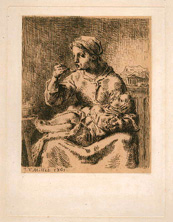|

|
|
La Bouillie
Delteil 17,
Melot 17
etching and drypoint,
1861, on beige Chine appliqué on medium-heavy white wove
paper, a very fine proof impression of the 3rd state (of 5),
with the engraved signature, but before letters, (and thus before
the first edition that was published in the Gazette des Beaux-Arts,
September 1861), with good margins, some very slight discolouration
overall, scattered foxmarks on the reverse, mostly in the margins,
otherwise in fine condition
P. 213x158mm., S. 293x230mm.
|
Philippe Burty, who commissioned
this etching for his article on Millet's prints in the Gazette
des Beaux-Arts, gives a full account of its creation with
the technical assistance of Bracquemond (as cited in Delteil):
"The copper was
frankly attacked. It was well bitten the first time. We covered
the background and had it bitten again. Lastly Millet insisted
on adding two touches of pure acid to the heads of the woman
and her child. As soon as the brush touched, Bracquemond quickly
splashed on drops of water. We went to Delâtre's. A worker
pulled some impressions for us. At the third, Millet filled in
a large white patch on the woman's neck with drypoint, added
a few lines to the shading in the bonnet, a few dots to the wrist
holding up the child. All in all, we had 19 printed, two of which
were retouched. Bracquemond is going to add the signature."*
Although he makes no
mention of the number of proofs pulled after the addition of the
signature (i.e., the 3rd state, like the present impression),
they may be considered quite rare: over the past five years to
our knowledge only one similar impression has appeared on auction
(see Sotheby's New York, 15 May 1997, #507) .
It may be added that the crispness of the present proof, and notably
the clear printing of the fine drypoint lines retouching the neck,
which break down in the edition, would tend to indicate that there
were very few of them pulled.

* "Le cuivre
était franchement attaqué. Il a bien mordu la première
fois. On a recouvert le fond et l'on a fait mordre de nouveau.
Enfin, Millet a tenu à poser lui-même deux touches
d'acide pur sur la tête de la femme et de son enfant. Aussitôt
que le pinceau avait touché, Bracquemond jetait vite des
gouttes d'eau. Nous sommes allé chez Delâtre. Un
ouvrier nous a tiré des épreuves. À la troisième,
Millet a bouché à la pointe-sèche un grand
clair sur le cou de la femme, mis quelques traits sur l'ombre
du bonnet, quelque points dans le poignet qui soutient l'enfant.
Nous avons fait tirer en tout 19, dont deux retouchées.
Bracquemond va y ajouter la signature."

